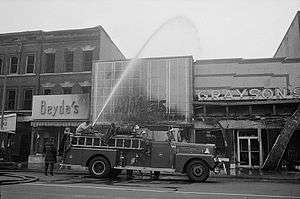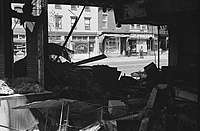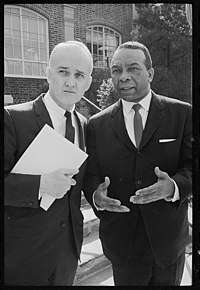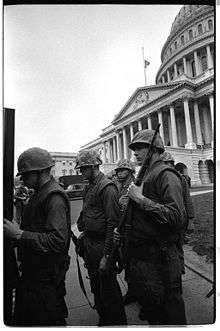1968 Washington, D.C. riots
| 1968 Washington, D.C. riots | |||
|---|---|---|---|
| Part of the King assassination riots | |||
 A firetruck douses smoldering shops burnt out during the riots | |||
| Date | April 4, 1968 – April 8, 1968 | ||
| Location |
Washington, D.C., U.S. 38°55′01″N 77°01′55″W / 38.91694°N 77.03194°WCoordinates: 38°55′01″N 77°01′55″W / 38.91694°N 77.03194°W | ||
| Caused by | Assassination of Martin Luther King, Jr. | ||
| Methods | Rioting, race riots, protests, looting, attacks | ||
| Parties to the civil conflict | |||
| |||
| Casualties | |||
| Death(s) | 12 | ||
| Injuries | 1,098 | ||
| Arrested | 6,100+ | ||
The Washington, D.C. riots of 1968 were 4 days of riots in Washington, D.C. that followed the assassination of civil rights activist Martin Luther King Jr. on April 4, 1968. The King assassination riots affected at least 110 U.S. cities; Washington, along with Chicago and Baltimore, were among the most affected.
Background
The ready availability of jobs in the growing United States government attracted many people to Washington in the 1960s, and middle class African-American neighborhoods prospered. While the black middle-class community prospered, the lower class was plagued by poor living conditions and fell deeper into poverty.[1]
Despite the end of legally mandated racial segregation after the 1954 decision of Brown v. Board of Education, the neighborhoods of Shaw, the Atlas District Northeast corridor, and Columbia Heights remained the centers of African-American commercial life in the city.
Pre-existing conditions
Housing
Housing in washington DC was deeply segregated. Mostly all of the slums in the city were in the southern quarter of the city, and most of the inhabitants of these slums were black. The United States Commission on Civil Rights said in a government report on segregation in Washington, D.C., that housing was much harder to attain than for whites, and of the housing blacks could find within the city's border was in severely worse condition than the housing of their white counterparts.[2] The same federal council also stated that it was HUD’s (Department of Housing and Urban Development) segregationist zoning plot for the city that was to blame for housing inequality. HUD also came under fire from a group called ACCESS (Action Coordinating Committee to End Segregation in Suburbs) when they protested HUD for giving federal money to buildings that restricted blacks from living in.[3]
Education
Ghettoization resultant from housing discrimination led into a feedback loop of low property taxes and low funding for public schools in DC, with many white parents sending children to private schools. Two thirds of D.C.'s population was black, 92% of public school children were black.[4] Striking statistics such as one out of three ninth grade public school students ending up graduating gave way to rising frustration from the black majority towards the white government and only gave way to louder and louder cries for home rule. The federal government granted $5.5 million under Title 1 of the American Secondary and Elementary Schools act but none of that money went to majority black schools.[5]
Police
With 80 percent of the police force being white and 67 percent of the city being black [6] tension between police and citizens rose along with tension between whites and blacks before 1968. The militarization of the police which started in the south in the Sixties to put a buffer on civil rights protests left inner city blacks nationwide more scared of police than ever. In the years leading up to 1968 there were many incidents in which Washington's black community held protests and turned angry against white police officers. In 1965, the same time and place as Martin Luther King worked with white lawmakers to pass the civil rights act, two white Washington, D.C., police officers arrested a group of black boys with ages ranging from 12 to 16 for playing basketball in an alley. This prompted majority black crowds to gather around police stations around the city throwing rocks and in some cases firecrackers. These small disorderly protests would happen multiple times before the end of 1965.[4] There were three programs put in place after a long string of controversial arrests of black people by white officers. Firstly, a police run Department of Community Relations, a citizen-run Advisory Council for every precinct, and a Complaint Review Board made up of citizens that would look over complaints thrown out by the police chief and see if the complaint warranted a look at a repeal by the mayor. In 1968, before the riots began, a popular black D.C. reverend said that black citizen and white cop relations had reached a "danger point."
Unemployment
In June 1967, the national unemployment rate was 4% for white Americans and 8.4% for non-white Americans.[6] In Washington, D.C., non-white unemployment was over 30% for much of the 1960s, many times higher than national rates.[4]
Course of events

Looting and arson

On the evening of Thursday, April 4, as word of King's assassination in Memphis, Tennessee spread, crowds began to gather at the intersection of 14th and U Streets. Stokely Carmichael, the militant civil and political rights activist who had parted with King in 1966 and had been removed as head of the Student Nonviolent Coordinating Committee in 1967, led members of the SNCC to stores in the neighborhood demanding that they close out of respect. Although polite at first, the crowd fell out of control and began breaking windows. Carmichael, who supported the riots, told rioters to "go home and get your guns."[7]
The disturbances began when a window was broken at the People's Drug Store at the intersection of 14th and U Streets, NW.[8] An hour and half later, by 11 p.m., window-smashing and looting spread throughout the area. Looting occurred generally where there was little police protection. The local police department could not handle the disturbance, as one officer said, "This situation is out of control, we need help it's too much for us to handle."[9] The civil disturbance unit was later activated, but by the time order was restored around 3 a.m., 200 stores had their windows broken and 150 stores were looted, most of them emptied. Liquor stores were hardest hit. Black store owners wrote "Soul Brother" on their storefronts so that rioters would spare their stores.[10]
The D.C. fire department reported 1,180 fires between March 30 and April 14 of 1968 as arsonists set buildings ablaze.[11]
Carmichael speeches
The next morning, Mayor-Commissioner Walter Washington ordered the damage cleaned up immediately. However, at 10 a.m., anger was still evident when Carmichael addressed a rally, saying "white America has declared war on black America", there is "no alternative to retribution" and "Black people have to survive, and the only way they will survive is by getting guns".[7] "White America killed Dr. King last night. She made a whole lot easier for a whole lot of black people today. There no longer needs to be intellectual discussions, black people know that they have to get guns. White America will live to cry that she killed Dr. King last night. It would have been better if she had killed Rap Brown and/or Stokley Carmichael, but when she killed Dr. King, she lost."[12] "I think white America made its biggest mistake when they killed Dr. King last night... He was the one man in our race who was trying to preach mercy and forgiveness for what the white man has done." He said "Execution of this retaliation will not be in the courts but in the streets,...We're going to die on our feet-we’re tired of living on our stomachs."[13]
During a Havana broadcast, he told blacks to stay away from their jobs to protest the slaying and "make the white racist Americans understand that Negroes have the necessary force to set right the outrages which have been made against Negroes in the United States."[14]
Clashes with police and firefighters
Rioters walking down 7th Street NW and in the Atlas District came into violent confrontations with the Metropolitan Police Department of the District of Columbia. Around midday, arsonists set buildings ablaze while firefighters were attacked with bottles and rocks and unable to address the fires. By 1 p.m., the riot was once again in full effect. Police unsuccessfully attempted to control the crowds using tear gas.[15]
Presidential radio address
In a radio address after the announcement of King's death, President Lyndon B. Johnson asked all citizens not to resort to violence. The following morning, he held a meeting at the White House with black civil rights leaders and government officials. He made a statement saying to "deny violence its victory," and he said that all citizens must come together to keep King's dream alive. He declared the Sunday of that week to be Martin Luther King Jr. Day, a day of mourning. In addition, he ordered that all the American flags across federal and District buildings, grounds, and naval vessels, and at diplomatic and military vessels overseas be flown at half staff. He also made the final decision to bring in the national guard so that order would once again rule in the city.
Mayor-Commissioner Walter E. Washington attempts to quell the violence

Walter Washington made nightly appearances during the riots, and these appearances were credited by many in the city with helping dampen the violence during the time. In addition, he refused FBI director J. Edgar Hoover's commands to shoot at rioters.[16] In 1974, Washington was elected as the city's first elected mayor and its first black mayor, but only served one term after being overwhelmed with managing the city.[17][18]
Coordination by Cyrus R. Vance
Cyrus R. Vance was the former Deputy Secretary of Defense and special Pentagon representative in D.C. 1968 Riots. Mayor Washington acted with Vance’s guidance during Thursday night, the first hours of rioting. He also acted as the Pentagon’s special representative from Friday night and on. He was called upon by Mayor Washington on Friday afternoon to coordinate the National Guard, the Army, and the police. He was the leading force in a shift in the military emphasis which focused on the overwhelming use of men, the use of tear gas, and an early, strictly enforced curfew.[19]
Police response
Before the riots, Layton, the police chief of Washington, emphasized that if there ever was a riot in Washington, he would use a large number of policemen with no guns, rather than fewer policemen with guns. During the riots, Layton put those words into action. Rather than acting immediately to the reports of rioting, looting, and window-breakings with a smaller force, he played the waiting game until a large enough force could be brought together. They then used tear gas instead of bullets to disrupt the rioting.[20]
Military intervention

| Wikisource has the original text of Johnson's order dispatching troops: |
On Friday, April 5, the Office of the President dispatched some 13,600 federal troops, including 1,750 federalized D.C. United States National Guard troops to assist the overwhelmed D.C. police force.[15] Marines mounted machine guns on the steps of the Capitol and army troops from the 3rd Infantry guarded the White House. At one point, on April 5, rioting reached within 2 blocks of the White House before rioters retreated. The occupation of Washington was the largest of any American city since the Civil War.
The National Guard imposed a strict curfew, worked riot control, patrolled the streets, guarded looted stores, and provided aid to those who were misplaced by the rioting. The National Guard continued to remain after the rioting had officially ceased to protect against a second riot and further damage.[21][7][8]
Deaths
By Sunday, April 8, when the city was considered pacified, 13 people had been killed in fires, by police officers, or by rioters.[22][23] An additional 1,097 people were injured and over 7,600 people were arrested.[24]
| Name | Race | Gender | Age | Cause of death | Location of death | (Order died) Date of death |
|---|---|---|---|---|---|---|
| George Marvin Fletcher | White | Male | 28 years old | Stabbed in confrontation with eight African-American youth | Gas station near 14th and U Street, NW | a. Thursday, April 4, 1968 |
| Unidentified teenager | Black | Male | 14~ years old | Killed in fire | G.C Murphy Store, 3128 14th Street, NW | b. Friday, April 5, 1968 |
| George W. Neely | Black | Male | 18 years old | Killed in fire | G.C Murphy Store, 3128 14th Street, NW | c. Friday, April 5 ~12:20 p.m, 1968 |
| Unidentified teenager | Black | Male | 14–17 years old | Killed in fire | Morton’s store, 7th and H Streets | d. Friday, April 5 ~4 p.m, 1968 |
| Vincent Lawson | Black | Male | 15 years old | Killed in fire | Warehouse at 653 H St. NE, next to Morton's store | e. Friday, April 5, 1968; remains discovered in 1971[23] |
| Harold Bentley | Black | Male | 34 years old | Killed in fire | 513 8th Street, NE, I-C Furniture Company | f. Friday, April 5, 1968 |
| Thomas Stacey Williams | Black | Male | 15 years old | Shot by policeman[25] | Near 42nd Street, NE, 20019 | g. Friday April 5 ~6 p.m, 1968 |
| Ernest McIntyre | Black | Male | 20 years old | Shot by policeman[25] | 4009 South Carolina St., by Al’s Liquor Store | h. Friday, April 5, 1968 |
| Annie James | Black | Female | 52 years old | Smoke inhalation from fire[22] | Apartment above Quality Clothing Store at 701 Q St. NW | i. Friday, April 5, 1968 |
| Ronald James Ford | Black | Male | 29 years old | Bled to death after slashing his neck and chest on a broken store window[26][22] | Found outside the playground fence of Cardozo High School on 13th Street NW[22] | j Saturday, April 6, 1968 |
| Cecil Hale ‘Red Rooster’ | Black | Male | 40~ years old | Smoke inhalation from fire | Carolina Market, 1420 7th Street, NW | k. Sunday, April 7, 1968 |
| William Paul Jeffers | Black | Male | 40 years old | Killed in fire | Jan's Drygoods Store, 1514 7th Street, NW | l. Sunday, April 7, 1968 |
| Fred Wulf | White | Male | 78 years old | Found unconscious, allegedly beaten by black youths, developed pneumonia at hospital | Sidewalk at New Jersey and H streets | m. Monday, April 8, 1968 |
Civil Rights Act
On April 11, 1968, Johnson signed the Civil Rights Act of 1968, which included the Fair Housing Act and prohibited discrimination concerning the sale, rental and financing of housing based on race, religion, national origin or gender. While a bill had been in question for some time, Johnson sped up the process following the assassination of Dr. King. The Act helped desegregate D.C. and reduced the amount of blacks living in ghettos, separated from wealthier whites-only areas.[29][30][31]
Rebuilding after the riots
Fauntroy's proposal
Walter Fauntroy, City Council vice chairman and the leader of the Southern Christian Leadership Conference, played a key role in the rebuilding of D.C. after the 1968 riots. When the riots first broke out, Fauntroy expressed his connection with Dr. King, stating that "There is no one in the city whose heart is more crushed and broken than (his)" after King's assassination. He challenged people to "Handle your grief the way Dr. King would have wanted it," and those who acted otherwise "do dishonor to the life and mission of Dr. King." Following the riots, Fauntroy proposed a program that would allow property owners the right to build bigger and more profitable buildings as long as they spend money on community projects such as housing, apartment renovations or retail centers. If someone wanted to go forward with a commercial project, they would need to first make a firm commitment to undertake a local project in a D.C. neighborhood. As part of their returning to the community, participants would be required to return 50% of the cash value of the bonuses they received through the program. Fauntroy estimated an increase of $500 million in revenue for the city government.[32]
Property damage and White flight
The property loss caused by the riots was extensive and included damage to 1,199 buildings, including 283 housing units and 1,590 commercial establishments. Estimates of losses to at least partially insured properties in the concentrated area of looting and destruction were fixed at $25 million. Insurance covered only 29% of the total loss suffered by these businesses. As a result of the riot damage, an estimated 2,900 insurance policies were cancelled and 500 businesses suffered inflated insurance rates. The board of trade estimated a loss of $40 million in tourist trade during the months of April and May including the cancellation of the National Cherry Blossom Festival.[33]
The riots devastated Washington's inner city economy. With the destruction or closing of businesses, thousands of jobs were lost, and insurance rates soared. Made uneasy by the violence, White flight from the city accelerated, depressing property values. Crime in the burned out neighborhoods rose sharply, further discouraging investment.
On some blocks, only rubble remained for decades. Columbia Heights and the U Street corridor did not begin to recover economically until the opening of the U Street and Columbia Heights Washington Metro stations in 1991 and 1999, respectively.
See also
- List of incidents of civil unrest in the United States
- 1968 New York City riot
- 1968 Detroit riot
- 1968 Chicago riots
- Louisville riots of 1968
- Baltimore riot of 1968
- 1968 Pittsburgh riots
- 1968 Kansas City, Missouri riot
- Wilmington riot of 1968
- Protests of 1968
- Hard Revolution, novel by George Pelecanos
References
- ↑ Fisher, Marc; Pianin, Eric (April 4, 1988). "THE RIOTS AND D.C.'S UNDERCLASS". The Washington Post.
- ↑ "Civil Rights USA: Housing in D.C.". The United States Commission on Civil Rights.
- ↑ "HUD prolongs segregation in housing, ACCESS says". Washington Post. August 19, 1967. Retrieved July 14, 2015.
- 1 2 3 Ben, Gilbert (1968). Ten Blocks from the White House. Praeger.
- ↑ Filson, Susan (June 10, 1967). "School Aid System Creates Inequities".
- ↑ "Unemployment Unchanged". 22 July 1969. Retrieved July 17, 2015.
- 1 2 3 FRANKLIN, BEN A. (April 6, 1968). "Army Troops in Capital as Negroes Rio". The New York Times.
- 1 2 WILLS, Denise kersten (April 1, 2008). "People Were Out of Control: Remembering the 1968 Riots". Washingtonian.
- ↑ Brimelow, Ben (April 4, 2018). "Photos show present-day Washington, DC compared with the explosive 1968 riots that followed Martin Luther King Jr.'s death 50 years ago today". Business Insider.
- ↑ Brown, DeNeen L. (March 26, 2018). "A black bank witnessed devastation after the 1968 riots. Now 'the future is bright.'". The Washington Post.
- ↑ "The 1968 Riots". Curbed.
- ↑ "Martin Luther King Assassination". United Press International. 1968.
- ↑ Walsh, Kenneth T. (April 4, 2018). "A Dream Denied". US News & World Report.
- ↑ "Dr. King's Death Stuns Black, White Americans". The Lawton Constitution. April 5, 1968.
- 1 2 Risen, Clay (2009). "April 5: 'Official Disorder on Top of Civil Disorder'". A nation on fire : America in the wake of the King assassination. Hoboken, N.J.: John Wiley & Sons. ISBN 978-0-470-17710-5.
- ↑ Coleman, Milton; Timberg, Craig (October 28, 2003). "Unifier Led D.C. Into Home Rule; Tact Helped City Withstand Crises". The Washington Post.
- ↑ Coleman, Milton; Timberg, Craig (October 28, 2003). "Unifier Led D.C. Into Home Rule". The Washington Post.
- ↑ "Walter Edward Washington, 88; Mayor of D.C. Prevented Big Riots". Los Angeles Times. Associated Press. October 28, 2003.
- ↑ W. Gilbert, Ben (10 May 1968). Ten Blocks from the White House. Greenwood Publishing Group. pp. 33, 74, 92.
- ↑ Gilbert, Ben W. (10 May 1968). Ten Blocks from the White House. Greenwood Publishing Group. pp. 34, 35.
- ↑ Gilbert, Ben W. (10 May 1968). Ten Blocks from the White House. Greenwood Publishing Group. pp. 42, 57, 68, 73, 74, 92.
- 1 2 3 4 5 Ruane, Michael E. (March 26, 2018). "The riot dead: Teenagers, a recovering mental patient, and two shot by police". The Washington Post. ISSN 0190-8286.
- 1 2 3 Gaines-Carter, Patrice (April 5, 1988). "FOR RIOT VICTIMS' KIN, THE PAIN ENDURES". The Washington Post. ISSN 0190-8286.
- ↑ Ruane, Michael E. (March 26, 2018). "Fifty years ago some called D.C. 'the colored man's paradise.' Then paradise erupted". The Washington Post. ISSN 0190-8286.
- 1 2 Duggan, Paul; Williams, Clarence (2018-03-26). "After bloodshed in earlier U.S. riots, D.C. police showed restraint in 1968 unrest". Washington Post. ISSN 0190-8286. Retrieved 2018-04-05.
- ↑ "The four days in 1968 that reshaped D.C." Washington Post. Retrieved 2018-04-05.
- ↑ Gilbert, Ben (1968). Ten Blocks From the White House. New York City: Frederick A. Praeger. pp. 52–93.
- ↑ Goldchain, Michelle. "D.C.'s most famous protests, rallies, and riots, mapped". Curbed.
- ↑ SMITH, MERRIMAN (April 5, 1968). "Johnson urges nation to mourn King without violence". United Press International.
- ↑ "Remarks Upon Signing the Civil Rights Act". University of California, Santa Barbara. April 5, 1968.
- ↑ "History of Fair Housing". United States Department of Housing and Urban Development.
- ↑ Mintz, John (April 7, 1988). "INVESTORS RECLAIMING RIOT CORRIDORS". The Washington Post.
- ↑ Brownell, Richard (April 4, 2017). "John Layton, the M.P.D., and the 1968 Washington Riots". WETA (FM).
Further reading
- Bean, Jonathan. "'Burn, Baby, Burn': Small Business in the Urban Riots of the 1960s" (PDF), The Independent Review 5:2, Fall 2000, pp. 165–187
- CNN: "Nation's capital still recovering from 1968 riots," April 4, 1998
- Tucker, Neely. "The Wreckage of a Dream," The Washington Post August 24, 2004, p. B01
- Gilbert, Ben W. (1968) Ten Blocks from the White House, Anatomy of the Washington Riots of 1968. The Washington Post. Frederick A. Praeger Publishers.
- Williams, Paul Kelsey Greater U Street Charleston, SC: Arcadia Publishing, 2002.
- Williams, Paul Kelsey & T. Luke Young. Washington Then and Now Charleston, SC: Arcadia Publishing, 2002.
- Wills, Denise Kersten. "'People Were Out of Control': Remembering the 1968 Riots", Washingtonian, April 2008.
- "The Riots of '68" by ghostsofdc.org - blog including video footage and photos of Washington after the riots
- "The 1968 Riots in Washington, DC" - blog of Federal records describing damage in the National Archives